Viewing a File System¶
You can search for file systems by file system name keyword and view their basic information.
Procedure¶
Log in to the SFS console.
In the file system list, view the file systems you have created. Table 1 describes the file system parameters.
Table 1 Parameter description¶ Parameter
Description
Name
Name of the file system, for example, sfs-name-001
Data Redundancy Policy
Only Multi-AZ is supported currently.
AZ
Availability zone where the file system is located
Status
Possible values are Available, Unavailable, Frozen, Creating, Deleting, Deletion error, Creation failed, Expanding, Expansion error, Capacity reducing, Capacity reduction error, and Capacity reduction failed.
Protocol Type
File system protocol, which is NFS
Used Capacity (GB)
File system space already used for data storage
Note
This information is refreshed every 15 minutes.
Maximum Capacity (GB)
Maximum capacity of the file system
Encrypted
Encryption status of the file system. The value can be Yes or No.
Mount Point
File system mount point, which is in the format of File system domain name:/Path or File system IP address:/
Note
If the mount point is too long to display completely, adjust the column width.
Operation
For an SFS Capacity-Oriented file system, operations include resizing, deletion, and monitoring metric viewing.
For an SFS Turbo file system, operations include capacity expansion, deletion, and monitoring metric viewing.
For a general purpose file system, operations include deletion only.
Click the name of a file system to view detailed information about the file system.

Figure 1 Basic information of an SFS Capacity-Oriented file system¶

Figure 2 Details of a general purpose file system¶

Figure 3 Details of an SFS Turbo file system¶
(Optional) Search for the specified file system by file system name.
You can search for SFS Capacity-Oriented file systems by tag in the upper right area above the file system list.
On the displayed Search by Tag tab page, enter a tag key and a tag value (must be among existing keys and values) and click Search.
You can use more than one tag for a combination search. Each time after a key and a value are entered, click
 . The added search criteria are displayed under the text boxes. When more than one tag is added, they will be applied together for a combination search. A maximum of 20 tags can be added at a time.
. The added search criteria are displayed under the text boxes. When more than one tag is added, they will be applied together for a combination search. A maximum of 20 tags can be added at a time.You can click Reset under the search criteria to reset.